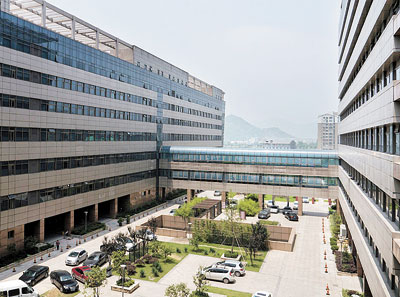|

JUST before midnight, the pavement outside the glowing high-rise towers of the First Affiliated Hospital of Zhengzhou University is littered with slumbering bodies. Splayed on colorful mats or tucked into folding cots, these are patients’ relatives.
Inside, beds line hallways and crowd elevator lobbies while relatives share gurneys with patients and doze in brightly lit stairwells. The world’s biggest hospital with about 7,000 beds, Zhengzhou First Affiliated, in Central China, is still not big enough.
“My dad paid for a bed but still couldn’t get one,” said Ma Wenxiao, a university student from the central city of Wuhan, whose father waited two days for a bed after travelling to Zhengzhou for chemotherapy.
Demand for healthcare is booming in China, driven by a growing middle class, improved health insurance coverage and an aging population. In response, some of the country’s public hospitals are adding beds by the thousand.
China now has 16 public hospitals with more than 3,000 beds. But the expansion has policymakers worried.
Hospital build-outs testify to a lack of public confidence in rural healthcare. They add to local government debt and may not be providing cost-effective care.
Last summer, the Central Government issued a directive restricting expansion of public hospitals, but hospital administrators appear to be finding ways around it.
Hospitals’ building binge, and the government’s response, highlights the dilemmas facing the country’s healthcare system, experts say. In China today, says Liu Tingfang, a professor at Tsinghua University, “hospitals have to expand if they want to survive.”
Despite government efforts to encourage patients to use smaller local hospitals, most Chinese still feel safer being treated for everything from ear aches to emphysema in major university-affiliated hospitals in big cities.
Hospital heads, too, believe that bigger is better.
Government funding provides less than 10 percent of State hospital operating budgets, and the State holds public hospital fees low to keep care affordable.
As China has chipped away at the drug mark-ups they once relied on, many hospitals see expansion as a way to raise revenues.
Big hospitals often have support from local governments, which approve and help fund hospital expansion in part because they are evaluated on their ability to drive growth.
Patients come expecting to see top doctors, says Li Huijuan, a Beijing-based lawyer who handles medical cases.
But rapidly expanding hospitals have to hire less experienced medics, says Li, creating a gap between patient expectations and reality that “can cause or exacerbate conflicts between doctors and patients.” Rapid expansion can also increase pressure on medical personnel, as increases in bed numbers may outpace growth in staffing levels.
An official at Zhengzhou First Affiliated said the large volume of patients was a reflection of demand, and that the hospital did daily inspections to ensure patient safety. According to its website, it plans to add 3,000 beds at another location.
The problems that giant hospitals create ripple through China’s healthcare system. Some 60 to 80 percent of patients in big hospitals could be treated at community medical centers, says Ma Jingdong, associate professor at Huazhong University of Science & Technology in Wuhan.
(SD-Agencies)
|

